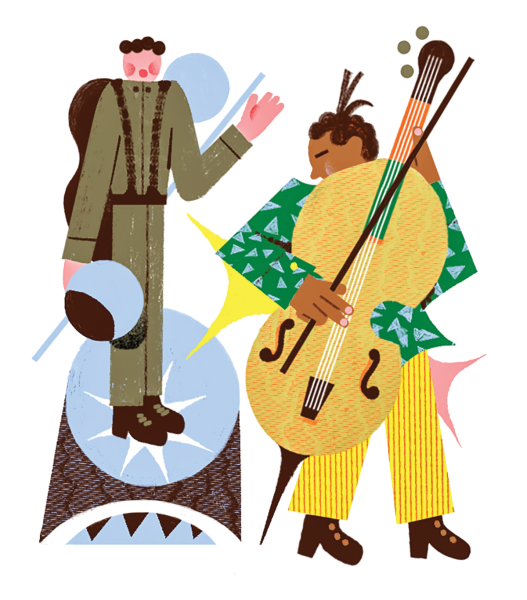
Save this storySave this storySave this storySave this story
Shauna Lyon
Goings On editor
You’re reading the Goings On newsletter, a guide to what we’re watching, listening to, and doing. Sign up to receive it in your in-box.
Beyond the fade of sweet summer lies a particularly sparkly fall culture season packed with tantalizing shows—enough to rival a political showdown for the ages. Stars hitting New York stages include Robert Downey, Jr., Mia Farrow, Adam Driver, Rachel Zegler, Patti LuPone, and Kenneth Branagh; Tammy Faye Bakker and Norma Desmond also make appearances. “Brat” summer continues into the cooler months, as Charli XCX hits Madison Square Garden with Troye Sivan; Sabrina Carpenter and Billie Eilish continue their world domination. The Met, MOMA, and the Guggenheim celebrate undersung artists and lesser-known movements in tentpole shows, and the Brooklyn Museum mounts a paean to gold. The New York Philharmonic welcomes a slew of guest conductors; American Ballet Theatre premières a dance based on “Crime and Punishment.” The TV season heats up with an unrecognizable Colin Farrell as the Penguin, and Nicole Kidman, Cate Blanchett, and Kathy Bates lend charismatic mystery to new dramas. At the movies, anticipated works from Tim Burton, Francis Ford Coppola, Sean Baker, and Robert Zemeckis compete for popcorn sales with two unbeatable matchups: Clooney-Pitt and Joaquin-Gaga. Onward and upward with the arts!
Jump to: The Theatre | Contemporary Music | Art | Movies | Television | Classical Music | Dance
The Theatre

Illustrations by Sergey IsakovDouble Acts, Stars Galore
Broadway sheds its summer lassitude with a season of starry double acts: Patti LuPone and Mia Farrow cohabitate in Jen Silverman’s “The Roommate” (Booth; starting previews Aug. 29); Ayad Akhtar’s “McNeal” stars Robert Downey, Jr., and his “metahuman digital likeness” (Vivian Beaumont; Sept. 5); Julianna Margulies and Peter Gallagher swoon in Delia Ephron’s romance “Left on Tenth” (James Earl Jones; Sept. 26); Helen J. Shen and Darren Criss play love-struck robots in the musical “Maybe Happy Ending” (Belasco; Oct. 16); and, in David Henry Hwang’s Obie-winning “Yellow Face” (Todd Haimes; Sept. 13), Daniel Dae Kim stars as the playwright’s own conflicted doppelgänger.
London sends Broadway its most emotional fare with “The Hills of California,” Jez Butterworth’s seventies family drama (Broadhurst; Sept. 11); Jamie Lloyd’s blood-soaked version of Andrew Lloyd Webber’s “Sunset Blvd” (St. James; Sept. 28); and Elton John’s teary new musical, “Tammy Faye” (Palace; Oct. 19). As ever, there’s a dash of Shakespeare: Sam Gold directs “Romeo and Juliet,” starring Rachel Zegler, at Circle in the Square (Sept. 26), and Kenneth Branagh plays “King Lear” at the Shed (Oct. 26). But much of the homegrown season consists of classic American cultural touchstones. Kenny Leon stages Thornton Wilder’s “Our Town” (Ethel Barrymore; Sept. 17); James Monroe Iglehart plays Louis Armstrong in “A Wonderful World” (Studio 54; Oct. 16); the Avett Brothers score the shipwreck musical “Swept Away” (Longacre; Oct. 29); and the beloved “Ragtime” is at Encores! (City Center; Oct. 30-Nov. 10).
The Americana energy extends downtown, too: “Gatz,” Elevator Repair Service’s marathon staging of “The Great Gatsby,” returns (Public Theatre, Nov. 1), and Adam Driver goes country for a revival of Kenneth Lonergan’s “Hold on to Me Darling,” at the Lortel (Sept. 24). And, as always, we Americans look to the movies. The nineties cult hit “Death Becomes Her” rises again as a musical (Lunt-Fontanne; Oct. 23), and the indie “Safety Not Guaranteed” gets its own musicalization at BAM (Sept. 17).
Happily, our favorite playwrights all seem to have premières this season: Robert O’Hara’s “Shit. Meet. Fan.” opens at MCC in October; Hoi Polloi presents “Family” (site-specific; Sept. 12), an early play by Celine Song (“Past Lives”); James Ijames follows “Fat Ham” with “Good Bones” (Public; Sept. 19); and the Bushwick Starr mounts “A Woman Among Women,” by the deft Julia May Jonas (Oct. 15). Signature Theatre’s Dominique Morrisseau series continues with “Bad Kreyol” (Oct. 8), while Katori Hall unfurls “The Blood Quilt,” at Lincoln Center (Mitzi E. Newhouse; Oct. 30) and Ethan Lipton switches on his new musical, “We Are Your Robots” (Polonsky Shakespeare Center; Nov. 10). Sarah Mantell’s “In the Amazon Warehouse Parking Lot” launches the Playwrights Horizons season on Oct. 11, and Soho Rep bids farewell to the scrappy, miniscule Walker Space with Branden Jacobs-Jenkins’s “Give Me Carmelita Tropicana!” (Oct. 23). Talk about your double acts: Soho Rep will soon move into the Playwrights building, on Forty-second Street, and these two indispensable institutions will be roommates for a few seasons to come.—Helen Shaw
Contemporary Music

Charli XCX, Childish Gambino, Bikini Kill
The fall concert schedule kicks off with Afrofuturism and theatricality. The Afropunk Festival returns to Brooklyn, on Aug. 23-24, with the BLKTOPIA event headlined by Erykah Badu, and, days later, the renaissance man Donald Glover closes the curtain on his eclectic Childish Gambino project at Barclays Center (Aug. 26-27), alongside the star-child Willow. Early September keeps the hits coming with incomparable noise artists, sound designers, and genre distillers. At Radio City Music Hall, the Afro-R. & B. trailblazer Tems (Sept. 5) and the modern soul man Jon Batiste (Sept. 6-7) unleash voices that seem to filter history. Things amp up at Brooklyn Paramount with the reunited riot grrrls of Bikini Kill (Sept. 7-8) and the guitar heroics of St. Vincent (Sept. 10-11). The bilingual pop shape-shifter Omar Apollo stops at Forest Hills Stadium for the “God Say No” tour (Sept. 7), and the composer-titan Hanz Zimmer brings cinematic sounds to Madison Square Garden (Sept. 12).
As fall gets into full swing, M.S.G. opens its doors for the main characters of this year’s pop summer, allowing them to settle into their victory laps: Charli XCX christens the success and excess of “Brat,” alongside the “Rush” sensation Troye Sivan (Sept. 23); Sabrina Carpenter relishes the newfound glow brought on by her pair of catchy, chart-conquering bops, “Please Please Please” and “Espresso” (Sept. 29); and Billie Eilish restlessly navigates the curious sounds of her May album, “Hit Me Hard and Soft” (Oct. 16-18). The arena also hosts Vampire Weekend (Oct. 5-6), which is again in rare form on the recent album “Only God Was Above Us,” and remains an indie-rock lodestar even as the genre’s locus shifts.
Beyond the Garden, there is no shortage of artists in full bloom. The singer-songwriter Mk.gee goes lo-fi at Terminal 5, on Sept. 25, and the English d.j. and producer Nia Archives trots out dance music for introverts at Brooklyn Steel, on Oct. 11. Webster Hall spotlights Ravyn Lenae’s tinsel R. & B. (Oct. 8) and Empress Of’s incandescent pop (Oct. 15), as Bowery Ballroom invites the “tenderpunk” of Illuminati Hotties (Oct. 18) and the Music Hall of Williamsburg showcases the slacker rocker MJ Lenderman (Oct. 25-27). In an inspired union of artist, venue, and moment, BAM’s Howard Gilman Opera House welcomes the experimentalist ANOHNI (Oct. 18-19) for her first shows with the Johnsons in a decade.—Sheldon Pearce
Art

Fallible Flesh, Orphism, Gold
This fall belongs to groups. Relatively few of the tentpole art exhibitions have an individual at their center, and several of the most intriguing ones celebrate movements that, for as many reasons as there are tourists at the Met, still lack for fame. Shaker furniture is world famous for its plain, proto-minimalist design; to begin to understand nineteenth-century Shaker drawing, picture the exact opposite. A blast of bright color and wiggly shapes, sometimes verging on the psychedelic, is coming to the American Folk Art Museum under the banner of “Anything But Simple: Gift Drawings and the Shaker Aesthetic” (opening Sept. 13).
The place of Siena in Italian art history may seem as shaky as Florence’s and Rome’s are secure. There’s a very simple explanation: in the middle of the fourteenth century, a plague picked off the city’s finest painters, including Duccio, Simone Martini, and Ambrogio and Pietro Lorenzetti. Even if these Masters died just when things were getting interesting, they were crucial superspreaders of the Renaissance, as anyone who attends “Siena: The Rise of Painting, 1300-1350,” at the Met (Oct. 13), will be able to confirm.
Nobody could mistake the theme of MOMA’s “Vital Signs: Artists and the Body” (Nov. 3) as neglected—it’s hiding in plain view. More than a hundred works, mainly from the permanent collection, depict strange, sacred, fallible flesh, with special attention paid to the ways in which bodies are sorted by race and gender. Look out for drawings by Christina Ramberg, coming off of an excellent retrospective at the Art Institute of Chicago, and Bhupen P. Khakhar’s ecstatic “Kali,” making its first appearance in these galleries.
Orphism, one of the most fascinating also-rans of European modernist painting, began, much like a rom-com, with the opposites-attract collision of hot, bright Fauvism and dun, jumbled Cubism. Its key figures, such as Robert and Sonia Delaunay and František Kupka, were prolifically inventive, but they lack, at least right now, the visibility of Picasso or Matisse. The Guggenheim’s “Harmony and Dissonance: Orphism in Paris, 1910-1930” (Nov. 8) pays them some overdue attention.
Should the halos in Sienese painting whet your appetite for expensive, shiny, metal stuff, the Brooklyn Museum has just the thing. “Solid Gold” (Nov. 16) assembles more than four hundred works, including altarpieces, coins, designer clothing, sculptures, and jewelry. Is there an argument behind any of this—something about the perils of extraction, maybe? Does anybody need one to see this show? It’s gold.—Jackson Arn
Movies

Auteurs Return, Along with Clooney and Pitt
The season’s releases launch a spate of likely awards contenders from a wide range of well-established auteurs, starting with Tim Burton’s “Beetlejuice Beetlejuice” (Sept. 6). This sequel reunites many of the characters from the 1988 original, bringing back actors including Michael Keaton, Catherine O’Hara, and Winona Ryder, for the reopening of a portal to the Afterlife, by the teen daughter (Jenna Ortega) of Ryder’s (now grown) character. Francis Ford Coppola’s long-planned superspectacle, “Megalopolis” (Sept. 27), which he self-financed, stars Adam Driver, Giancarlo Esposito, Nathalie Emmanuel, Aubrey Plaza, and Shia LaBeouf, in a drama that maps political conflicts of ancient Rome onto a futuristic science-fiction version of New York. Tom Hanks and Robin Wright star in “Here” (Nov. 1), Robert Zemeckis’s adaptation of a graphic novel by Richard McGuire, a fantasy about the lives lived on a single plot of land in the course of thousands of years.
Ambitious movies from younger directors of international renown are also en route, such as Sean Baker’s “Anora” (Oct. 18), a drama about a stripper (Mikey Madison) who marries a Russian oligarch’s son (Mark Eydelshteyn). Steve McQueen’s “Blitz” (Nov. 1) is centered on the experiences of a child (Elliott Heffernan) in London during the Second World War. And Andrea Arnold’s “Bird” (Nov. 8), starring Barry Keoghan, Franz Rogowski, and Nykiya Adams, lends the story of a poor family in Kent a supernatural twist.
The season’s star vehicles come in many forms. In the French director Coralie Fargeat’s horror drama “The Substance” (Sept. 20), Demi Moore plays an actress who undergoes a gruesome treatment to recover her youth. “Wolfs” (Sept. 20), directed by Jon Watts, showcases George Clooney and Brad Pitt as competing fixers forced to coöperate in the coverup of a murder. Joaquin Phoenix returns as the title character of “Joker: Folie à Deux” (Oct. 4), partnered with Lady Gaga, as Harley Quinn; Todd Phillips directed.
American independent filmmaking is the source of some of fall’s most notable releases. Zia Anger’s drama “My First Film” (Sept. 6) is based on her performance piece about her own unfinished movie; Odessa Young stars. In Aaron Schimberg’s “A Different Man” (Sept. 20), Sebastian Stan plays an actor with facial tumors; after having them removed, he experiences unexpected changes in his career and his life. “Christmas Eve in Miller’s Point” (Nov. 15), directed by Tyler Taormina, is a teeming comedy of an extended family’s conflicts and epiphanies amid rowdy holiday celebrations.—Richard Brody
Television

Colin Farrell’s Penguin, Cate Blanchett’s Thriller
TV gave us plenty of reasons to stay inside this summer, with big shows like “Bridgerton,” “The Bear,” “The Boys,” and “House of the Dragon.” In comparison, fall programming looks positively pared down. The buzziest—and most confusingly cast—might be HBO’s “The Penguin” (Sept. 19), in which the decidedly handsome Colin Farrell is made unrecognizable as the rather unhandsome Batman villain. An origin story inspired in part by the “Godfather” movies, “The Penguin” will find Farrell’s mobster protagonist squaring off against his deceased boss’s dangerous daughter, played by a promisingly against-type Cristin Milioti. Other I.P. gambles arrive, too. Kathryn Hahn resumes her scene-stealing role in Disney+’s “WandaVision” as the titular witch in a spinoff, “Agatha All Along” (Sept. 18), and a new version of “Matlock” (Sept. 22), on CBS, has Kathy Bates taking over the character from Andy Griffith.
Autumn’s most auspicious prestige play is arguably Apple TV+’s psychological thriller “Disclaimer” (Oct. 11), starring Cate Blanchett as a TV journalist who encounters a novel that’s seemingly based on her life, and on skeletons from her past; it’s written and directed by Alfonso Cuarón, with a supporting cast including Kevin Kline and Sacha Baron Cohen. History also gets dredged up in Hulu’s “Interior Chinatown” (Nov. 19), about a struggling actor (Jimmy O. Yang) who stumbles upon family secrets, and also a real crime, while working on a police procedural. In Starz’s “Three Women” (Sept. 13), a trio played by Betty Gilpin, DeWanda Wise, and Gabrielle Creevy choose to open up to a journalist, played by Shailene Woodley, about dysfunctional relationships in their lives. And I guess TV execs can’t stop planting dead bodies in affluent environs: on Sept. 5, Netflix débuts “The Perfect Couple,” set in Nantucket and starring Nicole Kidman.
On the lighter side, there’s the comedian Brian Jordan Alvarez’s “English Teacher” (Sept. 2), FX’s more adult answer to “Abbott Elementary,” which centers on well-meaning educators at an Austin high school who are chronically baffled by their students—and exhausted by the parents. Kristen Bell and Adam Brody tempt fate in the (hopefully not aptly named) Netflix rom-com “Nobody Wants This” (Sept. 26), about a rabbi and an agnostic who fall in love. An underfunded hospital is the unlikely comedic setting of Peacock’s “St. Denis Medical” (Nov. 12), from Justin Spitzer and Eric Ledgin, the team behind “Superstore” and “American Auto.” Meanwhile, the “Insecure” actress Natasha Rothwell gets her own starring vehicle in Hulu’s “How to Die Alone” (Sept. 13), about an airport worker who finally lets her long-suppressed aspirations take flight.—Inkoo Kang
Classical Music

Politics at the Met, Guests of the N.Y. Phil
Summer’s almost over, and politics are everywhere you look. At the Metropolitan Opera, a new opera by the famed Broadway composer Jeanine Tesori, “Grounded,” ponders a Reaper-drone pilot’s decisions and ethics; the mezzo-soprano Emily D’Angelo performs the lead (opening on Sept. 23). “Ainadamar,” Osvaldo Golijov’s tense, flamenco-inflected depiction of the life and assassination of Federico García Lorca, opens a few weeks later (Oct. 15), with Daniela Mack as the martyred socialist poet.
The New York Philharmonic, dramatically shorn of music director and president, turns the interregnum to its advantage, inviting an array of guest conductors to collaborate with the orchestra, among them, Michael Tilson Thomas (Sept. 12-13 and Sept. 15), Thomas Wilkins (Oct. 17-18), and Susanna Mälkki (Oct. 31-Nov. 2). The composer and conductor John Adams’s program (Nov. 14 and Nov. 16)—which includes his own “City Noir” and Gabriella Smith’s cello concerto “Lost Coast,” a nature-hymn-cum-climate-polemic performed by Gabriel Cabezas—may be a taste of things to come: the Los Angeles Philharmonic and Gustavo Dudamel, New York’s incoming music director, commissioned Smith’s piece. Dudamel leads the L.A. Phil as it opens Carnegie Hall’s season, with three Latin-themed programs, including a Spanish version of “A Midsummer Night’s Dream,” complete with Mendelssohn’s incidental music, one night (Oct. 9), and Natalia Lafourcade the next (Oct. 10).
On the same stage, the chamber choir the Crossing and a group of local military veterans are among the performers in the New York première of “Can We Know the Sound of Forgiveness,” by Gabriela Ortiz (Oct. 18); the Knights perform Gershwin’s “Rhapsody in Blue,” plus a new rhapsody by Michael Schachter (Oct. 24); and the innovative South African musician Abel Selaocoe, who joyfully layers Baroque cello technique with vocal traditions grounded in his homeland, appears with his group the Bantu Ensemble (Oct. 26).
Elsewhere, the Miller Theatre continues its “Composer Portraits” series with three recent pieces by Courtney Bryan, including her “Requiem,” performed by the Quince Ensemble’s quartet of sopranos (Sept. 12). At BAM, “Sun Dogs: Filmmaker and Composer Pairings” brings together such artists as Arooj Aftab and Apichatpong Weerasethakul (Nov. 18-19). National Sawdust premières Paola Prestini’s “Silent Light,” an opera that churns the curdling emotions of a Mennonite community (Sept. 26-29). Fourth Wall Ensemble sings Caroline Shaw’s “Partita” at the Angel’s Share, in Green-Wood Cemetery (Sept. 5-7). And, at Little Island, a last gasp of summer: the countertenor Anthony Roth Costanzo, ever a one-man band, sings every leading role in a reconceived chamber version of “The Marriage of Figaro” (Aug. 30-Sept. 22).—Fergus McIntosh
Dance

A Dostoyevsky Ballet, Fall for Dance
Every mid-September, the dance season goes from zero to sixty in an instant—suddenly, dance is everywhere. One of the opening acts is City Center’s Fall for Dance festival (Sept. 18-29), its tickets priced to sell out quickly (this year, at thirty dollars), its programs a cheerfully jumbled mix. Among the highlights is a visit by the National Ballet of Ukraine, based in Kyiv, with “Wartime Elegy,” a work that contrasts the anguish of the past two years with the high spirits of Ukrainian folk dance. It is by Alexei Ratmansky, a member of the company in the eighties and nineties, and now an artist-in-residence at New York City Ballet.
And, speaking of New York City Ballet, the company is marking various anniversaries (David H. Koch, Sept. 17-Oct. 12), including a half century since the première of George Balanchine and Alexandra Danilova’s “Coppélia,” and Justin Peck’s tenth year as resident choreographer. The latter occasion is met with an all-Peck program; “Coppélia” has the distinction of being one of the happiest ballets ever made, and also of being set to one of the most melodious of ballet scores, by Léo Delibes. Look out, too, for a smaller work, Lar Lubovitch’s “Each in Their Own Time,” a tender pas de deux for two men set to Brahms piano pieces.
When Bill T. Jones’s “Still/Here” premièred, in 1994, the AIDS epidemic was still raging. Through an exacting workshop process, Jones gathered stories and gestures from people facing illness and death and turned them into choreographic material. The result was like capturing lightning in a bottle, a work that takes on with great honesty, rawness, and grace the themes of fear, connection, and human dignity. It returns to BAM Oct. 30-Nov. 2.
Over at American Ballet Theatre (David H. Koch, Oct. 16-Nov. 3), the big reveal is a new evening-length work based on Dostoyevsky’s paranoid tale of violence and redemption, “Crime and Punishment,” not necessarily an obvious choice for a ballet. Its choreographer, Helen Pickett, is a former member of William Forsythe’s troupe and a sometime Wooster Group performer who has carved out a niche as a creator of dramatic ballets based on literary subjects. The company is also bringing back “La Bayadère,” but—cannily sidestepping the rest of the ballet’s exoticism—just the abstract, all-white-costumed “Shades” scene, one of the marvels of nineteenth-century repertoire.—Marina Harss
P.S. Good stuff on the Internet:
- This baseball-ballet moment
- Sade under the sea
- Baby beavers are born in London
Sourse: newyorker.com






